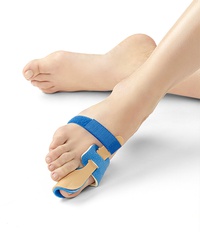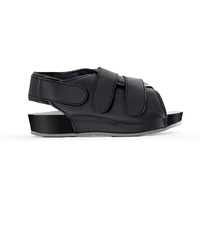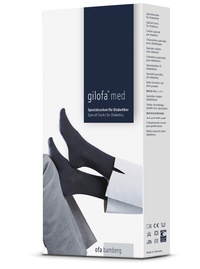Hallux Valgus
Painful deformity of the big toe
Hallux valgus is one of the most common diagnoses of painful deformities in the skeleton of the foot. Women in particular often suffer from the distinctive deformity of the big toe. Since the forefoot further widens as the condition progresses, purchasing shoes becomes a genuine challenge. But it’s the pain from the inflammation of the bursa and the development of calluses on the skin that make hallux valgus a serious problem.
What are the causes of Hallux Valgus?
Hallux valgus almost always occurs as a result of a splayfoot: the front transversal arch of the foot is flattened, which broadens the forefoot and causes the muscles to change their tensile direction. The first metatarsal bone increasingly declines outwards while the big toe tilts inwards and moves closer to the centre toes. Consequently, the distinctive deformity called hallux valgus develops. Insufficient training of the foot muscles or inactivity can further accelerate the condition. If the foot experiences the wrong type of strain on top of this or is being restricted inside the shoe, the hallux valgus can develop further. Familial predisposition can also play a role, however.


What kinds of treatment are available?
Primarily, the objective of the hallux valgus treatment has to be the elimination of the wrong strain and the correction of the initial deformity of the foot (usually splayfoot). To do this, relieving or supportive insoles are often used. Shoes that fit well and provide sufficient space for the foot are essential for the treatment. With the special stockings Gilofa Med Hallux Valgus, the big toe has even more space. A splint, like the Dynamics Hallux Valgus Night Splint, can correct the deformity of the primary joints of the toe via a lever mechanism.
If such conservative measures do not help to alleviate the pain, a surgical operation might have to be considered.
Preventing Hallux Valgus and other deformities
Our tip: Shoes that fit for healthy feet.
They carry us through life every day and do some extremely hard work along the way. Unfortunately, we don’t appreciate our feet’s performance sufficiently: incorrect footwear and deformities related to it are a primary reason for damage such as hallux valgus.
Our feet are so unique in their shape that a conventional shoe often doesn’t meet the needs – especially when one already suffers from congenital anomalies of the foot shape or in the case of an existing hallux valgus. Shoes that restrict the toes and immobilise the muscles instead of activating them during every step are particularly problematic. The prime example of this is pumps.
In order to activate the foot’s muscles, it is recommended to change shoes several times a day and, if possible, to choose appropriate footwear that doesn’t restrict the feet. Walking barefoot also activates the feet’s muscles and improves blood circulation. Moreover, exercise in general as well as special foot gymnastics and massages provide relief for our feet.






